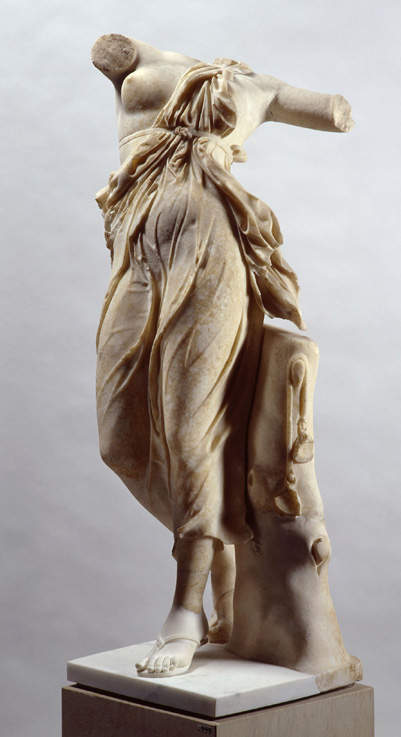This month’s sculpture from Hadrian’s Villa is a marble statue of a dancing female figure, thought to be a portrait of Praxilla of Sikyon.
Praxilla was a female poet writing in the mid-fifth century BC. She came from Sikyon, a city situated on a fertile coastal plain beside the Corinthian Gulf in the northeast Peloponnese (see images of the archaeological site here). She wrote, dithyrambs, hymns to the Greek gods as well as drinking songs (skolia). Her skolia were among the most celebrated of her time and were sung at banquets and festivals for over three hundred years.

Dancing female figure, thought to be a portrait of Praxilla of Sikyon, Palazzo Massimo alle Terme, Rome. Photo © Carole Raddato

Dancing female figure, thought to be a portrait of Praxilla of Sikyon, Palazzo Massimo alle Terme, Rome. Photo © Carole Raddato
The statue, made of white Pentelic marble, depicts the Greek lyric poetess in the dynamic act of dancing, probably to the rhythm of a double flute (aulos) held between her hands. She wears a loosely belted chiton which falls away, revealing her body as she moves. It is thought to be a copy of an original Greek bronze made in the 4th century BC by the famous Greek sculptor Lysippos (also from Sikyon).

Dancing female figure, thought to be a portrait of Praxilla of Sikyon, Palazzo Massimo alle Terme, Rome. Photo © Carole Raddato
The statue was found in the remains of the portico of the pecile at Hadrian’s Villa, a quadriporticus-garden with a long covered walkways delimiting a garden with a large pool in its centre.
In addition to the statue from Hadrian’s Villa, another Roman copy remains. It is known as the Berlin Dancer and is currently in the Staatliche Museum in Berlin. A smaller version (39,4cm) was sold at an auction at the Royal-Athena Galleries in 2006.

“Berliner Tänzerin” (Berlin Dancer) © Foto: Antikensammlung der Staatlichen Museen zu Berlin – Preußischer Kulturbesitz
Praxilla’s Poetry
Only eight fragments of Praxilla’s work have survived. The longest of them is an Hymn to Adonis. In this hymn, Adonis, who is confined in Hades, is being asked by those below what he misses most from the world above. He answers:
“Finest of all the things I have left is the light of the sun,
Next to that the brilliant stars and the face of the moon,
Cucumbers in their season, too, and apples and pears.”
(translated by Bernard Knox)
-
- Jane McIntosh Snyder, The Woman and the Lyre: Women Writers in Classical Greece and Rome. Carbondale: Southern Illinois University Press, 1989
- Praxilla – William Smith. A Dictionary of Greek and Roman biography and mythology
- Important Roman Marble Statue of Praxilla of Sicyon – Royal Athena Galleries (link)


